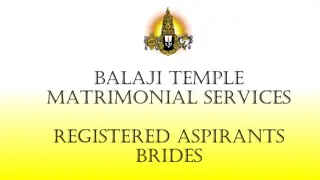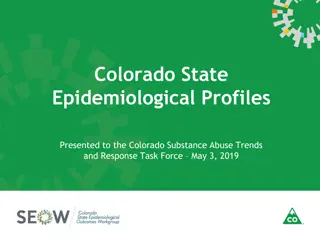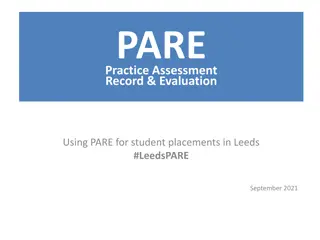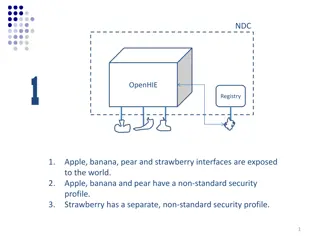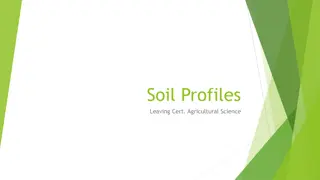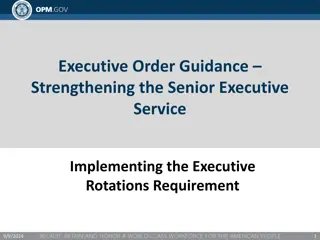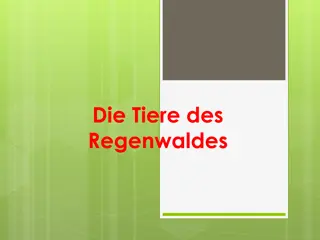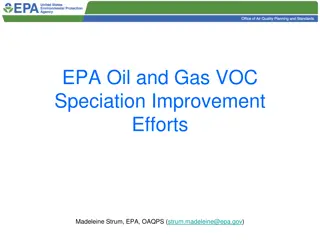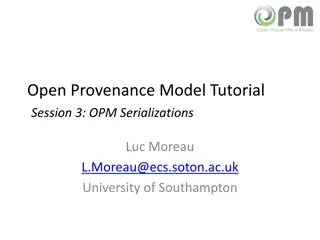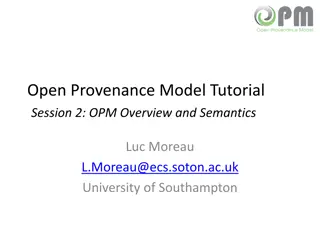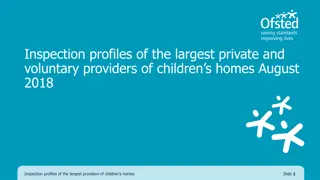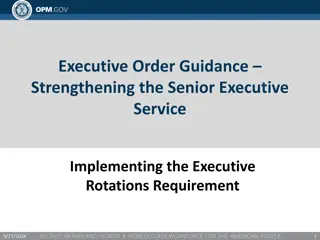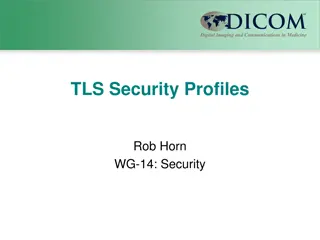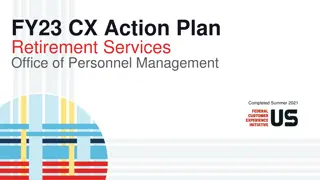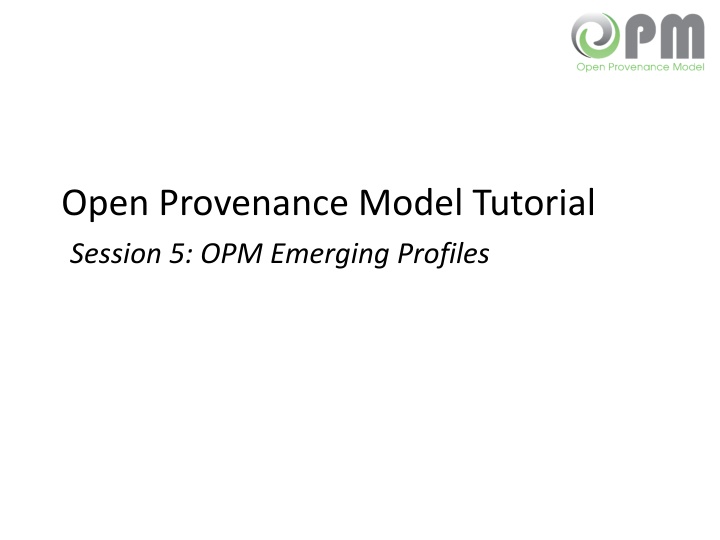
OPM Profiles for Provenance Modeling
Explore Session 5 of the Open Provenance Model Tutorial on OPM emerging profiles, profile definitions, and layered architecture. Learn about extending OPM through profiles, essential profiles, and domain specialization.
Download Presentation

Please find below an Image/Link to download the presentation.
The content on the website is provided AS IS for your information and personal use only. It may not be sold, licensed, or shared on other websites without obtaining consent from the author. If you encounter any issues during the download, it is possible that the publisher has removed the file from their server.
You are allowed to download the files provided on this website for personal or commercial use, subject to the condition that they are used lawfully. All files are the property of their respective owners.
The content on the website is provided AS IS for your information and personal use only. It may not be sold, licensed, or shared on other websites without obtaining consent from the author.
E N D
Presentation Transcript
Open Provenance Model Tutorial Session 5: OPM Emerging Profiles
Session 5: Aims In this session, you will learn about: How to extend OPM through profiles The content of a profile Four emerging profiles for OPM How to get involved with your own profile
Session 5: Contents Profile Definition Essential Profiles Collections Profile Signature Profile Domain Profiles Dublin Core Profile D-Profile Feedback
OPM Layered Model OPM Domain Specialization: Workflow, Web Technology Bindings: XML, RDF OPM based APIs: record, query OPM Essential Profiles: Collections, Attribution OPM Core OPM Sig 5
Concept of a Profile A specialisation of an OPM graph for a specific domain or to handle a specific problem Profile definitions are welcome! Note: profile multiplicity challenges inter- operability
Whats in a profile A unique id Vocabulary of Annotations Guidance Profile Expansion Rules Syntactical Short-cuts
Vocabulary of Annotations Controlled Vocabulary Subtyping of edges & nodes Application specific properties Easy! hasPhoto Reviewer Review reviewCreatedB y
Guidance Many ways to represent the same process within an OPM Graph System may expect a particular structure or associated vocabulary Reviewer Review reviewCreatedB y review draft Publishing System Reviewer Review submittedReviewFrom reviewFinalisedFrom
Profile Expansion Rules Provide more compact representations of provenance Maintain OPM Compatibility PS draft1 Reviewer Review reviewCreatedB y Rules review draft Publishing System Reviewer Review submittedReviewFrom reviewFinalisedFrom
Profile Compliance PROFILE Id Vocabulary Guidance Expansion directives Serialisation Profile Expansion Profile Compliant Graph Profile-expanded Graph
Profile Compliance Profile Compliant Graph Profile-expanded Graph OPM Inference Inferred Graph1 Inferred Graph 2
Syntactic Shortcuts Allow for parsimony in serializations Understand how to get back to the OPM model Paul Groth (Sept 18, 2010): review1, review2 for paper 12 Paul Groth r1 P12 Paul Groth r2
Profile Summary OPM is a top level representation Profiles allow for best practice & usage guidelines Defining community specific: Vocabulary Graph structure Derivations from vocabulary Serializations
http://www.flickr.com/photos/stripeyanne/3539864111/sizes/l/in/photostream/http://www.flickr.com/photos/stripeyanne/3539864111/sizes/l/in/photostream/
Provenance? http://www.flickr.com/photos/stripeyanne/3539864111/sizes/l/in/photostream/
Provenance? http://www.flickr.com/photos/stripeyanne/3539864111/sizes/l/in/photostream/
Provenance? http://www.flickr.com/photos/stripeyanne/3539864111/sizes/l/in/photostream/
Collection Profile (draft) with Paolo Missier, Paul Groth and Simon Miles Notion of collection (a kind of artifact) Collections can be nested Process types: constructor and artifact Edge types: contained, wasPartOf, wasIdenticalTo Completion guidance to derive dependencies on elements from collections
Collections From c2->c1, a1i->c1 derive a2i->a1i , c2->a2i And likewise from c2->c1, c2->a2i
Some Provenance Security Concerns How can we ensure the integrity of an OPM graph? Has it been tampered with? Is it authentic? Who created an OPM graph? Is there non-repudiable evidence that an entity is its author? Note: many other security requirements, cf. [Tan 06], [Braun 08], [Moreau 10].
Signature of OPM Graphs Cryptographic signatures provide: Non repudiable evidence Means to check authenticity Leveraging existing standards, e.g. XML- Signature Need to define a normal form for XML OPM graph before applying XML-Signature Implementation available from opm toolbox
Attribution and Signatures Embedded Signature Distinguished Name X509 Certificate An annotation to an OPM graph that contains a signature Timestamp and Replay Protection Role 27
Alternative implementation J. Myers (NCSA) implementation on top of RDF serialization More challenging since: There is no standard way of serializing RDF There is no standard RDF-Signature
Dublin Core Profile (draft) with Simon Miles and Joe Futrelle To many people, provenance is primarily about attribution, citation, bibliographic information DC provides terms to relate resources to such information DC profile aims to use of Dublin Core terms to OPM concepts and graph patterns http://twiki.ipaw.info/pub/OPM/ChangePropo salDublinCoreMapping/dcprofile.pdf
Dublin Core Terms Accrual method Available Bibliographic citation Contributor Publisher Date Version
dc:accuralMethod The method by which items are added to a collection I dc:accuralMethod M Collection Before Method (M) New item (I) Addition dc:versionOf New Collection
dc:publisher state=unpublished A1 publish Ag P wasSameResourceAs wasActionOf person name=Luc wasGeneratedBy A2 state=published
OPM benefit: refinement state=unpublished A1 review publish approve Ag P wasSameResourceAs wasActionOf person name=Luc wasGeneratedBy catalog A2 state=published
dc:contributor Ag A1 contribution P dc:isVersionOf wasGeneratedBy A2
OPM benefit: additional details Ag A1 contribution P dc:isVersionOf Contribution content used wasGeneratedBy A2
Provenance Across Applications Application Application Application Application Application Provenance Inter-Operability Layer The Open Provenance Model (OPM)
OPM Usage Thus Far OPM has been used for integration between monolithic systems Assumptions: Agreement between applications on integration points Little communication mostly through the environment Clear demarcation of functional components The other party is a good guy
OPM in Distributed Systems Is OPM suitable for Distributed Systems? Can OPM deal with asynchronous / synchronous systems failure, corruption, errors transient processes independent processes defining applications across systems
OPM in Distributed Systems Is OPM suitable for Distributed Systems? Can OPM deal with asynchronous / synchronous systems failure, corruption, errors transient processes independent processes defining applications across systems YES! (but we need some additions)
D-PROFILE A profile for modeling distributed systems within OPM Message-passing model Examples: Web services Pervasive systems Mobile
Vocabulary Edges WasConstructedFrom WasCopyOf WasSameMessageAs WasExtractedFrom Properties attributedTo tracer
Compact Representation Subclass of Artifact a D-Artifact Has annotations including: Payload for sender & receiver A message id Tracers Attribution Expansion Rules Save roughly half the nodes & edges
FEEDBACK: WHAT PROFILES ARE MISSING??
Extend OPM through a Profile Any one can make a profile (Go for it!) Easiest route is through a Vocabulary Post to the wiki and gain a community following Can also become endorsed Lightweight Governance Model http://twiki.ipaw.info/pub/OPM/WebHome/gover nance.pdf

